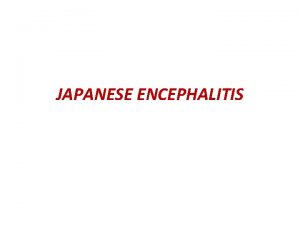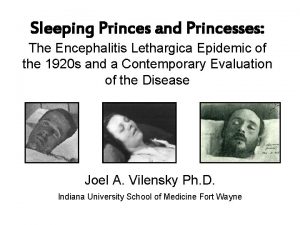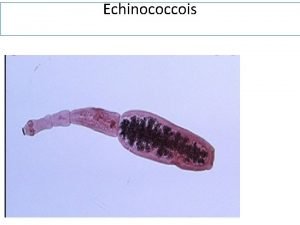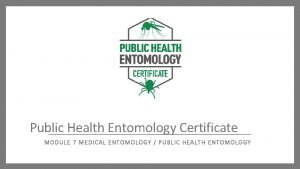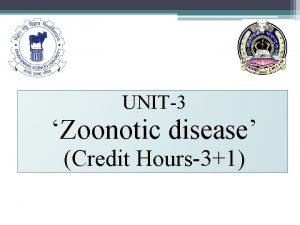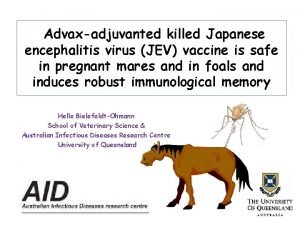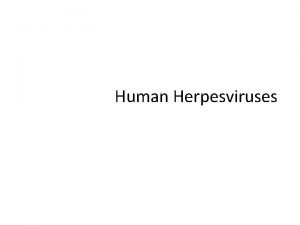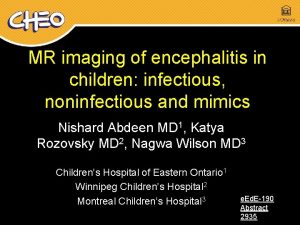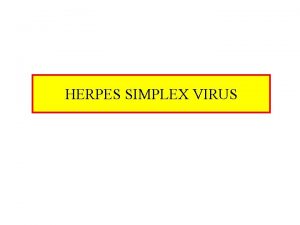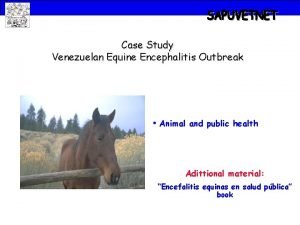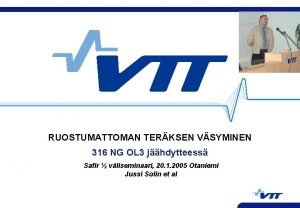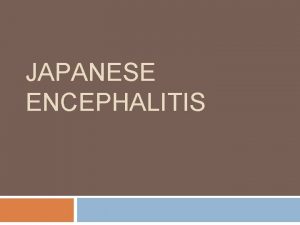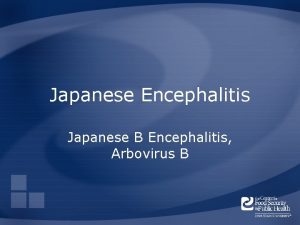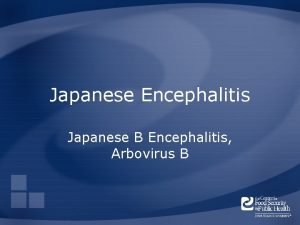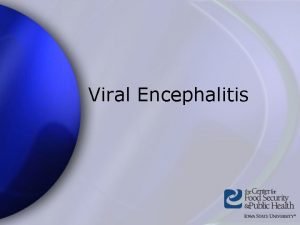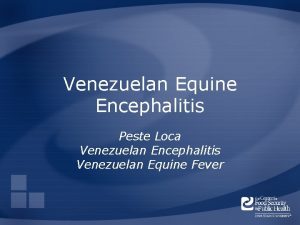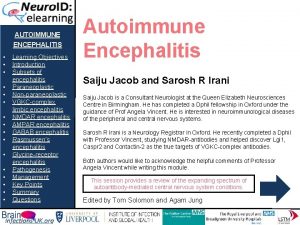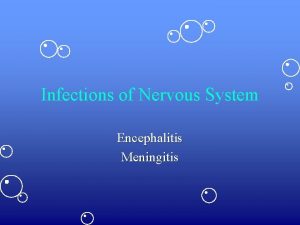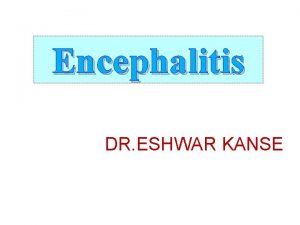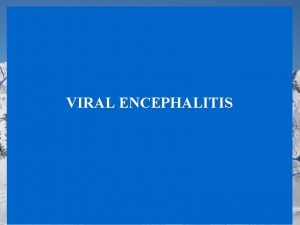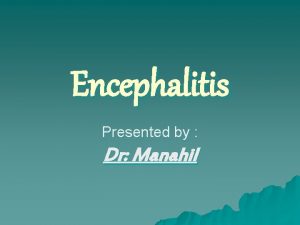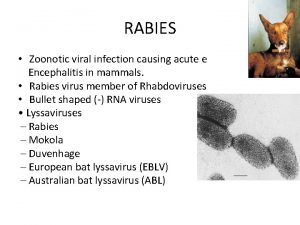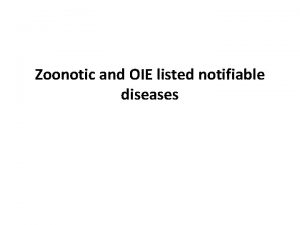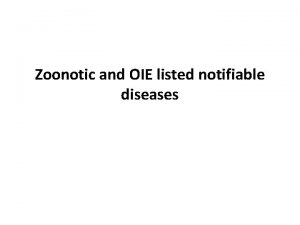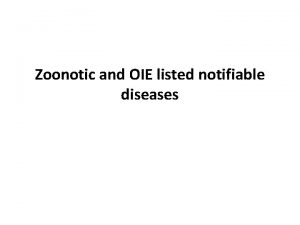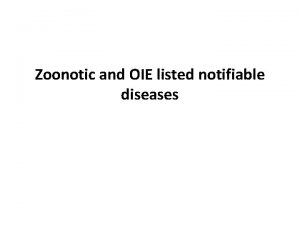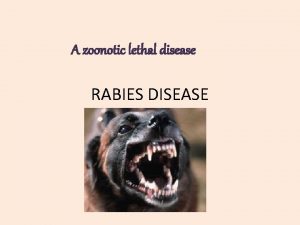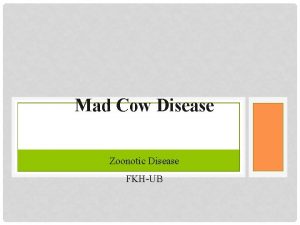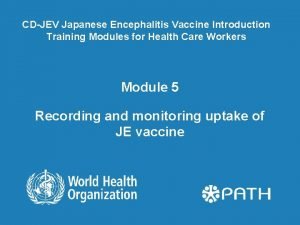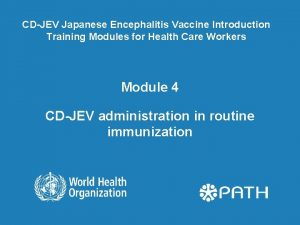JAPANESE ENCEPHALITIS Its a zoonotic disease i e


























- Slides: 26

JAPANESE ENCEPHALITIS

It’s a zoonotic disease i. e. infecting mainly animals and incidentally man. SYNONYMS: Japanese B Encephalitis, Arbovirus B Encephalitis, Mosquito-Borne Encephalitis, Russian Autumnal Encephalitis, Brain Fever, Summer Encephalitis.

AETIOLOGY Family: Flaviviridae Genus: Flavivirus Virions: Spherical, lipoprotein-enveloped particles being 40 -50 nm in diameter, 3 structural and 7 non- structural proteins Genome: Single stranded positive sense RNA of Antigenic Structure: Hemagglutinins, Complement Fixing Neutralising Antigens

Geographic Distribution • Major public health disease in Asia. • Virus first isolated in Japan in 1935. • As per WHO estimates 50 thousand serious cases and 10 thousand deaths each year. • Disease is prevalent in Indian Sub-continent. India – Epidemics • Number of endemic districts: 135; Population: 330 million Andhra Pradesh Assam Bihar Haryana Kerala Karnataka Maharashtra Manipur Nagaland Tamil Nadu Uttar Pradesh West Bengal

HOSTS Horses primary affected domestic animals of JE a dead-end host; other Equids (donkeys) are also susceptible. Pigs act as “amplifiers” of the virus producing high viraemias which infect mosquito vectors. AMPLIFYING HOST Reservoir for JE virus are birds of the family Ardeidae (herons and egrets) RESERVOIR HOST

LIFE CYCLE OF JAPANESE ENCEPHALITIS

TRANSMISSION Occurs by means of Mosquitoes - Principally Culex species mosquitoes; Culex tritaeniorhynchus is important as it has a wide host range that includes birds, horses, swine and humans. Oviposits in flooded fields (fish ponds, rice paddies and ditches) & is most active at twilight hours.

DYNAMICS OF JE TRANSMISSION Environment Host - Amplifying Vector Mosquito Host - Carrier Victim-Accidental Death Full Recovery with residual complications

PATHOGENESIS

JE IN MAN : CLINICAL FEATURES Incubation Period - 5 to 15 days Only 1 in 300 to 1 in 1000 infections develop into encephalitis, rest asymptomatic. Course of disease- 3 stages: Prodromal stage 1 to 6 days. Fever, headache and malaise. Acute encephalitic stage Fever, 38 to 40. 7°C, Nuchal rigidity, focal CNS signs, convulsion & altered sensorium progressing in many cases to coma. Late stage and sequelae: Temperature & ESR touch normal level, neurological signs become stationary


Morbidity/Mortality – Swine Equine Humans – High mortality – Morbidity: 2%, in piglets. during an outbreak. Varies between 20 -40% but it may reach 58% & over , higher in children. – Death rare in adult pigs. – Serious neurologic sequelae: 3350%. paralysis, brain damage etc. – Mortality: 5%. - In utero infection possible: Abortion of fetus Average period between the onset of illness & death is about 9 days.

Diagnosis and Treatment In Man Clinical SAMPLING • Notifiable disease. • Samples should be sent under secure conditions & to authorized laboratories to prevent the spread of the disease.

Laboratory Tests • Standard diagnostic test. Ig. M capture enzyme-linked immunoassay (ELISA) of serum or CSF Sensitivity is nearly 100% when both serum and CSF are tested. False-negatives may result if the samples are tested too early, as in the first week of illness. • New Ig. M dot enzyme immunoassays for CSF and serum Portable and simple tests that can be used in the field. Sensitivity and specificity are around 98 and 99% respectively. • Arbovirus Specific RNA detection RTPCR Viral RNA is extracted from serum or from suspected tissues of the patients or mosquito homogenates. • Virus isolation: Blood, CSF, or tissues

Post Mortem Lesions • Pan-encephalitis • • Oedema and congestion of brain & meninges Infected neurons scattered throughout CNS Occasional microscopic necrotic foci Thalamus generally severely affected

MEDICAL PROPHYLAXIS o Live attenuated vaccine Used in equine and swine Successful for reducing incidence o Inactivated vaccine (JE-VAX) Used for humans Used for endemic or epidemic areas Recommended for travelers Visiting endemic areas for > 30 days

VACCINATION OF HUMAN BEINGS • Currently 3 types of JE vaccines in large scale use are: 1. Mouse Brain-derived Purified & Inactivated Vaccine (Nakayama or Beijing strain of JE virus). 2. Cell Culture Derived Inactivated JE Vaccine (Beijing P-3 strain). 3. Cell Culture Derived, Live Attenuated Vaccine ( SA 14 – 2 strain of JE virus).



Prevention • Vector control – Eliminate mosquito breeding areas – Adult and larvae control • Vaccination – Equine and swine – Humans • Personal protective measures – Avoid prime mosquito hours – Use of repellants containing DEET

SANITARY PROPHYLAXIS: • Housing of animals in-doors in screened stabling can provide protection from mosquitoes. • Especially during active JE outbreaks & during peak vector activity (usually dusk to dawn) • Insecticides, repellants & fans also provide protection.

Vector control reduces transmission IN AFFECTED VILLAGES: - Aerial or ground fogging with ultra low volume insecticides - Spraying should cover vegetation around houses, breeding sites & animal shelters IN UNINFECTED VILLAGES: - Those falling within 2 -3 km radius of infected villages should also receive spraying as a preventive measur - Use of mosquito nets should be advocated

Case Definition : Suspected case Acute onset of fever (≤ 7 days) change in mental status With/ without New onset of seizures (excluding febrile seizures) (Other early clinical findings - may include irritability, somnolence or abnormal behaviour greater than that seen with usual febrile illness)

Probable Cases Suspected case in close geographic and temporal relationship to a laboratory-confirmed case of JE in an outbreak. Acute Encephalitis Syndrome due to other agent A suspected case in which diagnostic testing is performed an etiological agent other than JE is identified.

Acute Encephalitis Syndrome due to unknown agent A suspected case in which no diagnostic testing is performed / no etiologica. I agent was identified / test results were indeterminate. JE CASE CLASSIFICATION, NICD, NEW DELHI SUSPECT: A case that is compatible with the clinical description. PROBABLE: A suspect case with presumptive laboratory results. CONFIRMED: A suspected case that is laboratory confirmed.

 Culex mosquito
Culex mosquito Encephalitis lethargica
Encephalitis lethargica How to pronounce ueno
How to pronounce ueno Zoonotic
Zoonotic Public health entomology certificate
Public health entomology certificate Inscryption ringworm card
Inscryption ringworm card Equine encephalitis
Equine encephalitis Nursing diagnosis of meningitis slideshare
Nursing diagnosis of meningitis slideshare Trigemna
Trigemna Fever and headache
Fever and headache Hsv encephalitis
Hsv encephalitis Equine encephalitis
Equine encephalitis Nursing diagnosis of meningitis slideshare
Nursing diagnosis of meningitis slideshare Communicable disease and non communicable disease
Communicable disease and non communicable disease The emigree annotations
The emigree annotations Its not easy but its worth it
Its not easy but its worth it Windy cloudy rainy sunny
Windy cloudy rainy sunny If its square its a sonnet
If its square its a sonnet Its halloween its halloween the moon is full and bright
Its halloween its halloween the moon is full and bright When a train increases its velocity, its momentum
When a train increases its velocity, its momentum Political movement and beliefs japanese militarists
Political movement and beliefs japanese militarists Kore sore dore
Kore sore dore Paineastiateräs
Paineastiateräs The pet girl of sakurasou mc
The pet girl of sakurasou mc Reading in japanese
Reading in japanese Language japanese
Language japanese Nihongo quest alpha
Nihongo quest alpha
